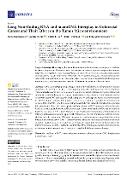Long Non-Coding RNA and microRNA Interplay in Colorectal Cancer and Their Effect on the Tumor Microenvironment

Author
Rajtmajerová, Marie
Publication date
2022Published in
CancersVolume / Issue
14 (21)ISBN / ISSN
ISSN: 2072-6694Metadata
Show full item recordCollections
This publication has a published version with DOI 10.3390/cancers14215450
Abstract
As the current staging and grading systems are not sufficient to stratify patients for therapy and predict the outcome of the disease, there is an urgent need to understand cancer in its complexity. The mutual relationship between tumour and immune or stromal cells leads to rapid evolution and subsequent genetic and epigenetic changes. Immunoscore has been introduced as a diagnostic tool for colorectal cancer (CRC) only recently, emphasising the role of the specific tumor microenvironment in patient's prognosis and overall outcome. Despite the fact that non-coding RNAs (ncRNAs), such as microRNAs (miRNAs) and long non-coding RNAs (lncRNAs), cannot be translated into proteins, they significantly affect cell's transcriptome and translatome. miRNA binding to mRNA efficiently blocks its translation and leads to mRNA destruction. On the other hand, miRNAs can be bound by lncRNAs or circular RNAs (circRNAs), which prevents them from interfering with translation. In this way, ncRNAs create a multi-step network that regulates the cell's translatome. ncRNAs are also shed by the cell as exogenous RNAs and they are also found in exosomes, suggesting their role in intercellular communication. Hence, these mechanisms affect the tumor microenvironment as much as protein signal molecules. In this review, we provide an insight into the current knowledge of the microenvironment, lncRNAs', and miRNAs' interplay. Understanding mechanisms that underlie the evolution of a tissue as complex as a tumour is crucial for the future success in therapy.
Keywords
CAFs, CRC, colorectal cancer, lncRNA, lymphocytes, macrophages, miRNA, tumor microenvironment
Permanent link
https://hdl.handle.net/20.500.14178/1625License
Full text of this result is licensed under: Creative Commons Uveďte původ 4.0 International







